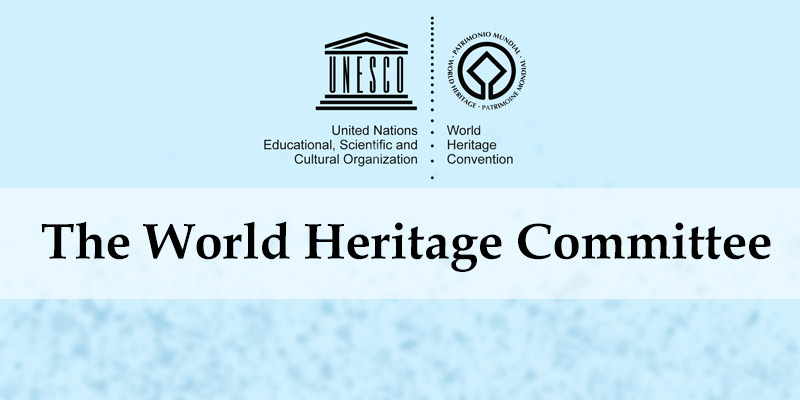It is a committee of the United Nations Educational, Scientific, and Cultural Organization. The Committee is responsible for the implementation of the World Heritage Convention, defines the use of the World Heritage Fund, and allocates financial assistance upon requests from States Parties. It has the final say on whether a property is inscribed on the World Heritage List. It examines reports on the state of conservation of inscribed properties and asks States Parties to take action when properties are not being properly managed. It also decides on the inscription or deletion of properties on the List of World Heritage in Danger. Structure: It consists of representatives from 21 of the States Parties to the Convention elected by their General Assembly. A Committee member’s term of office is six years, but most state parties choose voluntarily to be members of the committee for only four years in order to give other states parties an opportunity to be on the committee. Bureau of the World Heritage Committee: The Bureau consists of seven states parties elected annually by the Committee: a Chairperson, five Vice-Chairpersons, and a Rapporteur. The Bureau of the Committee coordinates the work of the Committee and fixes the dates, hours, and order of business of meetings. World Heritage Committee The World Heritage Committee meets once a year, and consists of representatives from 21 of the States Parties to the Convention elected by their General Assembly. • The Committee is responsible for the implementation of the World Heritage Convention, defines the use of the World Heritage Fund and allocates financial assistance upon requests from States parties. • It has the final say on whether a property is inscribed on the World Heritage List. • It examines reports on the state of conservation of inscribed properties and asks States Parties to take action when properties are not being properly managed. • It also decides on the inscription or deletion of properties on the List of World Heritage in Danger. World Heritage Committee members The current composition of the World Heritage Committee is: Argentina, Belgium, Bulgaria, Egypt, Ethiopia, Greece, India, Italy, Japan, Mali, Mexico, Nigeria, Oman, Qatar, Russian Federation, Rwanda, Saint Vincent and the Grenadines, Saudi Arabia, South Africa, Thailand, Zambia. What is a World Heritage Site? • The United Nations Educational, Scientific and Cultural Organisation (UNESCO) seeks to encourage the identification, protection and preservation of cultural and natural heritage around the world considered to be of outstanding value to humanity. • This is embodied in an international treaty called the ‘Convention Concerning the Protection of the World Cultural and Natural Heritage’, adopted by UNESCO in 1972. • A World Heritage Site is a place having a special cultural or physical significance and outstanding universal value to humanity. It may be a building, a city, a complex, a desert, a forest, an island, a lake, a monument or a mountain. • Sites recognised as being of Outstanding Universal Value are inscribed each year on the World Heritage List. World Heritage Sites in India • The number of UNESCO World Heritage Sites in India grew to 42 with the ‘Sacred Ensembles of the Hoysala’ finding a place in the coveted list in September 2023. • These sites include 34 in the cultural category, seven in the natural category and one mixed property. • They include Red Fort, Humayun Tomb and Qutub Minar in Delhi; Taj Mahal in Agra; ancient Nalanda university ruins and the Mahabodhi Temple in Bihar; and Santiniketan in West Bengal. • Currently, India has the sixth largest number of (UNESCO) sites in the world. The countries that have 42 or more world heritage sites are Italy, Spain, Germany, China and France. 46th session of the World Heritage Committee (WHC) In July 2024, India hosted the 46th session of the World Heritage Committee (WHC) in New Delhi. This event was a key moment in India’s efforts to protect its heritage. During the event, Prime Minister Narendra Modi announced a $1 million grant to support UNESCO’s global conservation efforts. India’s Commitment to Heritage Conservation India has been a strong supporter of the World Heritage Convention. It has actively participated in the WHC, serving four terms since 1977. India also works with other countries to build skills and provide technical help for heritage conservation. In the past decade, India has successfully added 13 cultural and natural sites to the World Heritage list. This makes India the sixth country globally in terms of World Heritage Sites, with a total of 43 sites. During the recent WHC session, the Moidams from Assam were recognized as India’s 43rd World Heritage Site. Highlights from the 46th WHC Meeting At the session, 24 new World Heritage Sites were added worldwide, including 19 cultural, 4 natural, and 1 mixed property. India also signed a Cultural Property Agreement with the USA to fight the illegal trade in cultural artifacts. Several heritage conservation projects were discussed at the event, including the Kashi Vishwanath Corridor and new initiatives at Nalanda University. India also partnered with international organizations like ICCROM to improve skills related to heritage preservation. A major exhibition at the WHC showcased 25 repatriated historical objects, demonstrating India’s dedication to preserving and promoting its cultural heritage. About World Heritage Sites Number and Distribution: There are over 1,100 World Heritage Sites recognized for their cultural or natural significance, spanning 167 countries, with Italy having the most sites at 58. Notable Facts: The first site listed in 1978 was the Galápagos Islands, and the Great Wall of China is the longest structure on the list. Sites can be added or removed, like Dresden, which was removed in 2009 due to development. Cultural Focus and Purpose: About 80% of the sites are Cultural Heritage Sites. The designation of these sites aims to promote conservation and raise awareness of their importance. FAQs What is the World Heritage Committee (WHC)? The World Heritage Committee is a group of representatives from 21 countries elected by the General Assembly of States Parties to the World Heritage Convention. It is responsible for the implementation of the World Heritage Convention, deciding which sites to inscribe on the World Heritage List, and



